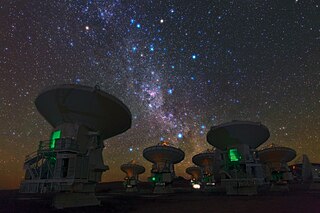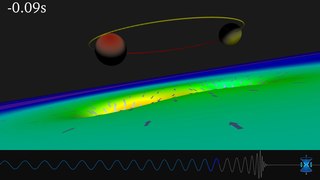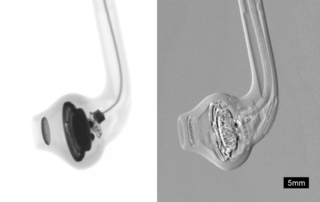Related Research Articles

In physics, interference is a phenomenon in which two coherent waves are combined by adding their intensities or displacements with due consideration for their phase difference. The resultant wave may have greater intensity or lower amplitude if the two waves are in phase or out of phase, respectively. Interference effects can be observed with all types of waves, for example, light, radio, acoustic, surface water waves, gravity waves, or matter waves as well as in loudspeakers as electrical waves.

A radio telescope is a specialized antenna and radio receiver used to detect radio waves from astronomical radio sources in the sky. Radio telescopes are the main observing instrument used in radio astronomy, which studies the radio frequency portion of the electromagnetic spectrum emitted by astronomical objects, just as optical telescopes are the main observing instrument used in traditional optical astronomy which studies the light wave portion of the spectrum coming from astronomical objects. Unlike optical telescopes, radio telescopes can be used in the daytime as well as at night.

Radio astronomy is a subfield of astronomy that studies celestial objects at radio frequencies. The first detection of radio waves from an astronomical object was in 1933, when Karl Jansky at Bell Telephone Laboratories reported radiation coming from the Milky Way. Subsequent observations have identified a number of different sources of radio emission. These include stars and galaxies, as well as entirely new classes of objects, such as radio galaxies, quasars, pulsars, and masers. The discovery of the cosmic microwave background radiation, regarded as evidence for the Big Bang theory, was made through radio astronomy.

Interferometry is a technique which uses the interference of superimposed waves to extract information. Interferometry typically uses electromagnetic waves and is an important investigative technique in the fields of astronomy, fiber optics, engineering metrology, optical metrology, oceanography, seismology, spectroscopy, quantum mechanics, nuclear and particle physics, plasma physics, biomolecular interactions, surface profiling, microfluidics, mechanical stress/strain measurement, velocimetry, optometry, and making holograms.

Very-long-baseline interferometry (VLBI) is a type of astronomical interferometry used in radio astronomy. In VLBI a signal from an astronomical radio source, such as a quasar, is collected at multiple radio telescopes on Earth or in space. The distance between the radio telescopes is then calculated using the time difference between the arrivals of the radio signal at different telescopes. This allows observations of an object that are made simultaneously by many radio telescopes to be combined, emulating a telescope with a size equal to the maximum separation between the telescopes.

Observational astronomy is a division of astronomy that is concerned with recording data about the observable universe, in contrast with theoretical astronomy, which is mainly concerned with calculating the measurable implications of physical models. It is the practice and study of observing celestial objects with the use of telescopes and other astronomical instruments.

The Michelson interferometer is a common configuration for optical interferometry and was invented by the 19/20th-century American physicist Albert Abraham Michelson. Using a beam splitter, a light source is split into two arms. Each of those light beams is reflected back toward the beamsplitter which then combines their amplitudes using the superposition principle. The resulting interference pattern that is not directed back toward the source is typically directed to some type of photoelectric detector or camera. For different applications of the interferometer, the two light paths can be with different lengths or incorporate optical elements or even materials under test.
Aperture synthesis or synthesis imaging is a type of interferometry that mixes signals from a collection of telescopes to produce images having the same angular resolution as an instrument the size of the entire collection. At each separation and orientation, the lobe-pattern of the interferometer produces an output which is one component of the Fourier transform of the spatial distribution of the brightness of the observed object. The image of the source is produced from these measurements. Astronomical interferometers are commonly used for high-resolution optical, infrared, submillimetre and radio astronomy observations. For example, the Event Horizon Telescope project derived the first image of a black hole using aperture synthesis.
In physics, the Hanbury Brown and Twiss (HBT) effect is any of a variety of correlation and anti-correlation effects in the intensities received by two detectors from a beam of particles. HBT effects can generally be attributed to the wave–particle duality of the beam, and the results of a given experiment depend on whether the beam is composed of fermions or bosons. Devices which use the effect are commonly called intensity interferometers and were originally used in astronomy, although they are also heavily used in the field of quantum optics.

In physics, the wavefront of a time-varying wave field is the set (locus) of all points having the same phase. The term is generally meaningful only for fields that, at each point, vary sinusoidally in time with a single temporal frequency.

An astronomical interferometer or telescope array is a set of separate telescopes, mirror segments, or radio telescope antennas that work together as a single telescope to provide higher resolution images of astronomical objects such as stars, nebulas and galaxies by means of interferometry. The advantage of this technique is that it can theoretically produce images with the angular resolution of a huge telescope with an aperture equal to the separation, called baseline, between the component telescopes. The main drawback is that it does not collect as much light as the complete instrument's mirror. Thus it is mainly useful for fine resolution of more luminous astronomical objects, such as close binary stars. Another drawback is that the maximum angular size of a detectable emission source is limited by the minimum gap between detectors in the collector array.
Lloyd's mirror is an optics experiment that was first described in 1834 by Humphrey Lloyd in the Transactions of the Royal Irish Academy. Its original goal was to provide further evidence for the wave nature of light, beyond those provided by Thomas Young and Augustin-Jean Fresnel. In the experiment, light from a monochromatic slit source reflects from a glass surface at a small angle and appears to come from a virtual source as a result. The reflected light interferes with the direct light from the source, forming interference fringes. It is the optical wave analogue to a sea interferometer.

A telescope is a device used to observe distant objects by their emission, absorption, or reflection of electromagnetic radiation. Originally it was an optical instrument using lenses, curved mirrors, or a combination of both to observe distant objects – an optical telescope. Nowadays, the word "telescope" is defined as a wide range of instruments capable of detecting different regions of the electromagnetic spectrum, and in some cases other types of detectors.

Gravitational waves are waves of the intensity of gravity that are generated by the accelerated masses of binary stars and other motions of gravitating masses, and propagate as waves outward from their source at the speed of light. They were first proposed by Oliver Heaviside in 1893 and then later by Henri Poincaré in 1905 as the gravitational equivalent of electromagnetic waves. Gravitational waves are sometimes called gravity waves, but gravity waves typically refer to displacement waves in fluids. In 1916 Albert Einstein demonstrated that gravitational waves result from his general theory of relativity as ripples in spacetime.

A gravitational-wave detector is any device designed to measure tiny distortions of spacetime called gravitational waves. Since the 1960s, various kinds of gravitational-wave detectors have been built and constantly improved. The present-day generation of laser interferometers has reached the necessary sensitivity to detect gravitational waves from astronomical sources, thus forming the primary tool of gravitational-wave astronomy.

A Fizeau interferometer is an interferometric arrangement whereby two reflecting surfaces are placed facing each other. As seen in Fig 1, the rear-surface reflected light from the transparent first reflector is combined with front-surface reflected light from the second reflector to form interference fringes.
In physics, ray tracing is a method for calculating the path of waves or particles through a system with regions of varying propagation velocity, absorption characteristics, and reflecting surfaces. Under these circumstances, wavefronts may bend, change direction, or reflect off surfaces, complicating analysis. Strictly speaking Ray tracing is when analytic solutions to the ray's trajectories are solved; however Ray tracing is often confused with ray-marching which numerically solves problems by repeatedly advancing idealized narrow beams called rays through the medium by discrete amounts. Simple problems can be analyzed by propagating a few rays using simple mathematics. More detailed analysis can be performed by using a computer to propagate many rays.
In optical astronomy, interferometry is used to combine signals from two or more telescopes to obtain measurements with higher resolution than could be obtained with either telescopes individually. This technique is the basis for astronomical interferometer arrays, which can make measurements of very small astronomical objects if the telescopes are spread out over a wide area. If a large number of telescopes are used a picture can be produced which has resolution similar to a single telescope with the diameter of the combined spread of telescopes. These include radio telescope arrays such as VLA, VLBI, SMA, astronomical optical interferometer arrays such as COAST, NPOI and IOTA, resulting in the highest resolution optical images ever achieved in astronomy. The VLT Interferometer is expected to produce its first images using aperture synthesis soon, followed by other interferometers such as the CHARA array and the Magdalena Ridge Observatory Interferometer which may consist of up to 10 optical telescopes. If outrigger telescopes are built at the Keck Interferometer, it will also become capable of interferometric imaging.
A common-path interferometer is a class of interferometers in which the reference beam and sample beams travel along the same path. Examples include the Sagnac interferometer, Zernike phase-contrast interferometer, and the point diffraction interferometer. A common-path interferometer is generally more robust to environmental vibrations than a "double-path interferometer" such as the Michelson interferometer or the Mach–Zehnder interferometer. Although travelling along the same path, the reference and sample beams may travel along opposite directions, or they may travel along the same direction but with the same or different polarization.

Phase-contrast X-ray imaging or phase-sensitive X-ray imaging is a general term for different technical methods that use information concerning changes in the phase of an X-ray beam that passes through an object in order to create its images. Standard X-ray imaging techniques like radiography or computed tomography (CT) rely on a decrease of the X-ray beam's intensity (attenuation) when traversing the sample, which can be measured directly with the assistance of an X-ray detector. However, in phase contrast X-ray imaging, the beam's phase shift caused by the sample is not measured directly, but is transformed into variations in intensity, which then can be recorded by the detector.
References
- 1 2 3 "Radio Astronomy at Dover Heights: Sea interferometry". CSIRO. 2008-02-05. Retrieved 2024-03-24.
- 1 2 3 4 5 6 Bolton, J. G.; Slee, O. B. (December 1953). "Galactic Radiation at Radio Frequencies V. The Sea Interferometer". Australian Journal of Physics. 6 (4): 420–433. Bibcode:1953AuJPh...6..420B. doi: 10.1071/PH530420 .
- ↑ Sullivan, W. T. III (1991). "Some highlights of Interferometry in early Radio Astronomy". In Cornwell, T. J.; Perley, R. A. (eds.). Radio interferometry: Theory, techniques, and applications; Proceedings of the 131st IAU Colloquium, ASP Conference Series. Vol. 19. San Francisco: Astronomical Society of the Pacific. p. 132. Bibcode:1991ASPC...19..132S. ISBN 0-937707-38-4.
- 1 2 3 4 Goss, W. M.; McGee, Richard X. (2010). Under the Radar: The First Woman in Radio Astronomy: Ruby Payne-Scott. Springer-Verlag. pp. 97–99. doi:10.1007/978-3-642-03141-0. ISBN 978-3-642-03141-0.
- ↑ Heywood, John (1969). Radio Astronomy and How to build your own Telescope (2nd ed.). New York: Arc Books inc. p. 90.
- ↑ Hey, J. S. (1973). The Evolution of Radio Astronomy. Histories of Science Series. Old Woking, Surrey: Paul Elek Scientific Books. p. 40. ISBN 0-236-15453-2.
- ↑ Robertson, Peter (1992). Beyond southern skies: radio astronomy and the Parkes telescope. University of Cambridge. pp. 42, 43, 46. ISBN 0-521-41408-3.